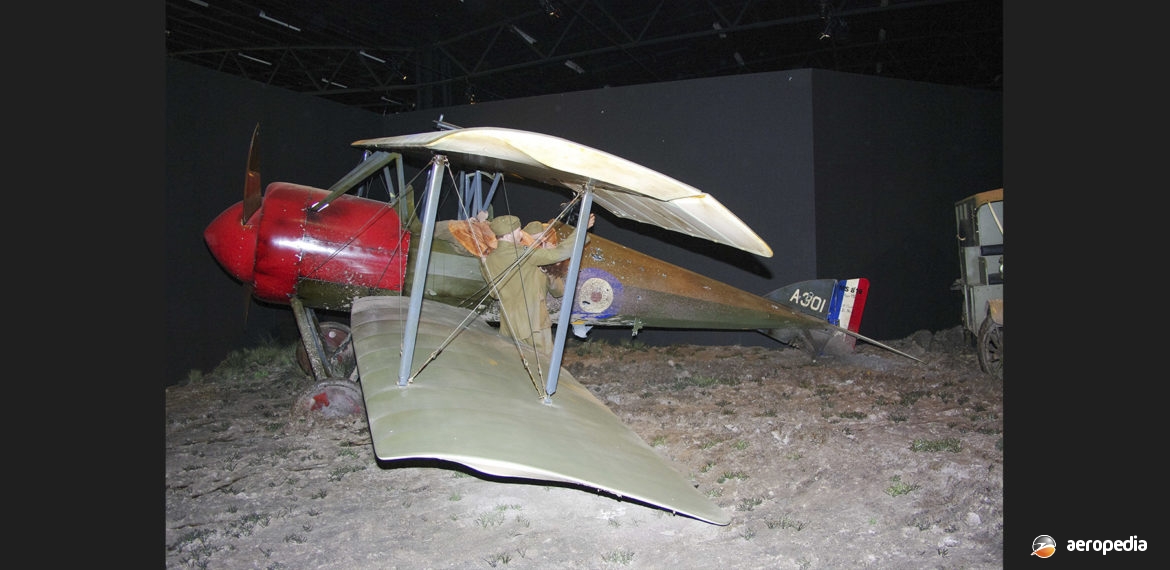Photograph:
A Morane Saulnier Type BB replica in the Omaka Heritage Centre, New Zealand (David C Eyre)
Country of origin:
France
Description:
Two-seat fighting scout
Power Plant:
One 60 kw (80 hp) Le Rhone 9J nine-cylinder single-row rotary engine of 911.4 cub in and weighing 146.5 kg (323 lb)
Specifications:
- Wingspan: 8.58 m (28 ft 2 in)
- Length: 6.93 m (22 ft 8 in)
- Height: 2.61 m (8 ft 7 in)
- Wing area: 22.32 m² (240.25 sq ft)
- Max speed at 3,050 m (10,000 ft): 134 km/h
- Climb to 1,980 m (6,496 ft): 13 mins
- Climb to 3,050 m (10,000ft): 26 mins 48 secs
- Ceiling: 3,660 m (12,008 ft)
- Empty weight: 491 kg (1082 lb)
- Loaded weight: 761 kg (1,678 lb)
Armament:
Two 7.7 mm (0.303 in) Lewis machine guns
History:
The Morane Saulnier Model BB was one of a number of fighter designs produced in France during World War I by Societe Anonyme de Aeroplanes Morane-Saulnier. In 1908 Raymond Saulnier joined Louis Bleriot and is said to have been involved in the design of the original Bleriot XI monoplane in which Bleriot made his cross-channel flight in 1909. Later that year he left Bleriot and designed a monoplane of his own. In 1909 Leon Morane joined Raymond Saulnier and, by 1911, Saulnier, Morane and Gabriel Borel joined forces to form a company to build aeroplanes. Borel only stayed a short time and thereafter the Company’s monoplanes of advanced design had a wide ranging effect on the market.
Initial aircraft were of shoulder wing configuration with wing-warping for lateral control. The fuselage was of wire-braced wooden structure in which the longerons tapered to a horizontal knife edge at the tail. Well known French pilot, Roland Garros, joined the company in 1912 and in December that year he flew one of the Company’s products from Tunis in Tunisia to Marsala in Sicily, later continuing to Rome, Italy. He made a number of noteworthy flights in Morane Saulnier aircraft.
By the commencement of hostilities in 1914 Morane Saulnier was producing fighter aircraft for the Allies. In 1915 the Type BB (Model M.57) appeared. This was a two-seat reconnaissance biplane similar in appearance to the earlier Type L. It was fitted with a 60 kw (80 hp) Le Rhone rotary engine but one was experimentally fitted with a 104 kw (140 hp) Hispano Suiza engine and this became known as the Type BH. This model was built under licence in Italy, and supplied to Belgium and the United Kingdom. In France it was built by Morane Saulnier and at the Dux factory, 80 being completed by MS and one by Dux, the latter differing in having two synchronized Vickers machine guns. One was supplied to the Royal Naval Air Service and served with No 3 Squadron from October 1915.
A replica of a Model BB was built and flown by the Ryder collection in the United States, this aircraft in 2006 being obtained for inclusion in the collection of World War I aircraft displayed at the Omaka Heritage Centre near Blenheim, NZ.

